- Inflation eases in 2015.
- The annual average consumer price index (CPI) in 2015 stood at 141.5 for the Philippines, 131.8 for the National Capital Region (NCR) and 144.6 for areas outside NCR (AONCR).
- The country’s annual average inflation decelerated to 1.4 percent in 2015 compared from 4.1 percent in 2014. It resulted from the negative annual average rates recorded in the indices of housing, water, electricity, gas and other fuels and transport. Also contributing to the downtrend were the slower annual average gains registered in the indices of eight commodity groups. During the year, the lowest inflation was in September and October at 0.4 percent while the highest rate was in February at 2.5 percent (Table 2.1)
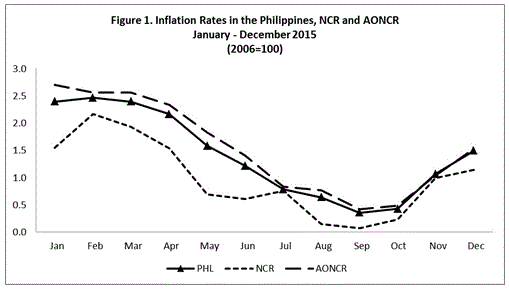
- All regions posted lower annual rates in 2015.
- The annual average inflation in NCR eased to 1.0 percent in 2015. It was registered at 3.2 percent in 2014.
- Similarly, the annual average inflation in AONCR improved to 1.5 percent in 2015. Last year, it was pegged at 4.5 percent.
- Among the regions in AONCR, the lowest annual average inflation in 2015 was recorded in CALABARZON at 0.9 percent while highest rate was noted in Davao Region and Autonomous Region in Muslim Mindanao (ARMM) at 2.6 percent (Table 1.1).
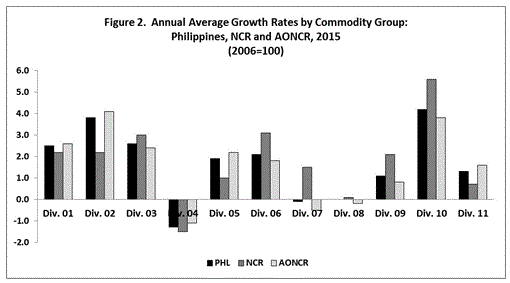

By Commodity Group
- Lower year-on-year growth rates seen in the prices of food items.
At the national level, declines in the annual average rates in 2015 were seen in the indices of housing, water, electricity, gas and other fuels and transport at -1.3 percent and -0.1 percent, respectively. The rest of the commodity groups posted slower annual average rates during the year except for communication index which posted a zero annual average growth.
In NCR, negative annual average rate during the year was likewise recorded in housing, water, electricity, gas and other fuels index at -1.5 percent. Lower annual average growths were also observed in all the other commodity groups except for the indices of transport and education whose rates were higher at 1.5 percent and 5.6 percent, respectively.
In AONCR, the annual average changes in the indices of housing, water, electricity, gas and other fuels fell by -1.1 percent in 2015; transport, -0.5 percent; and communication, -0.2 percent. The rest of the commodity groups exhibited slower annual average rates during the year.

Lower annual average increments in food and non-alcoholic beverages index were recorded in all the regions in 2015. The lowest annual average gain was seen in Northern Mindanao at 1.3 percent while the highest was in ARMM at 4.0 percent.
With all the regions recording either negative or slower annual average rates during the year, the annual average growths of the indices of rice in NCR and AONCR slowed down to 0.8 percent and 1.8 percent, respectively. The lowest annual average change was recorded in SOCCSKSARGEN at -2.7 percent. On the other hand, Central Luzon exhibited the highest rate at 4.1 percent. At the national level, the annual average rate decelerated to 1.7 percent in 2015.
In NCR, the annual average growth of the corn index rose by 7.5 percent. This was mainly effected by limited supplies of corn in the markets due to damage brought about by typhoon “Lando”. Meanwhile, the annual average increment of the corn index in AONCR improved to 0.1 percent in 2015. The lowest annual average rate was registered in SOCCSKSARGEN at -3.7 percent while the highest was in Davao Region at 6.6 percent. For the Philippines, the year-on-year growth of the corn index eased to 0.4 percent during the period.
The annual average increment in the meat index in NCR was slower at 1.9 percent and in AONCR, 1.7 percent. Lower annual increases, on the average, were noted in the prices of chicken, pork and beef. Among the regions, the lowest annual average growth was seen in Cagayan Valley at 0.1 percent while ARMM had the fastest annual average gain at 3.9 percent. For the Philippines, the annual average growth of the group’s index was pegged at 1.7 percent.
The fish index in NCR and AONCR correspondingly rose by 1.1 percent and 4.8 percent as lower production of selected fish species in some regions generally pushed up its prices during the year. These were, however, slower than their previous year’s annual growth at 6.8 percent and 5.0 percent, respectively. The lowest annual average growth of 1.9 percent was registered in ARMM while highest was in SOCCSKSARGEN at 10.7 percent. At the national level, the annual average growth of the group’s index decelerated to 4.3 percent.
The annual average uptick in milk, cheese and egg index slid to 2.4 percent in NCR and 2.8 percent in AONCR as most of the regions posted lower price increases in milk, cheese and eggs. At the country level, the annual average growth of the group’s index during the year moved up at a slower pace of 2.7 percent.
Increments in the prices of cooking oil pushed up the annual average rate of oils and fats index in NCR by 1.1 percent. In AONCR, the annual average uptick of the group’s index eased to 0.7 percent as eleven regions posted either negative or lower annual rates. The lowest annual average rate was in Northern Mindanao at -0.7 percent while the highest was noted in ARMM at 3.8 percent. For the Philippines, the annual average rate of the oils and fats index in 2015 slowed down to 0.7 percent.
In NCR, prices of selected fresh fruits such as banana, papaya, mango, and pineapple were generally higher during the year. Upward price adjustments in canned fruits were also observed. Hence, the annual average growth of fruits index in the area accelerated to 6.8 percent in 2015. In AONCR, the annual average increment in the group’s index decelerated to 7.4 percent as ten regions exhibited lower annual average rates. Among the regions, the lowest annual average growth in 2015 was seen in Davao Region at 1.3 percent while the highest was in ARMM at 12.8. At the national level, the annual average growth eased to 7.2 percent.
Supplies of vegetables in NCR markets were generally lower during the year. Thus, the vegetable index in NCR posted a higher annual average increment of 7.4 percent. However, all the regions in AONCR recorded either slower or negative annual average rates in 2015. This resulted to a lower annual average rate posted in the vegetable index in AONCR at 1.8 percent. Zamboanga Peninsula registered an annual average decline of -3.1 percent while ARMM had the highest annual average gain of 6.2 percent. For the Philippines, the annual average mark-up in the vegetable index improved to 2.7 percent.
The annual average growths in the indices of sugar, jam, honey, chocolate and confectionery in NCR were slower at 2.9 percent and in AONCR, 3.9 percent. The lowest annual average gain was recorded in Northern Mindanao at 1.5 percent while the highest was in Davao Region at 8.7 percent. The annual average growth of the group’s index at the national level decelerated to 3.8 percent.
Higher prices of selected spices, seasonings and condiments effected the 1.4 percent annual average growth in food products not elsewhere classified index in NCR and 4.5 percent in AONCR. These were however, slower than their corresponding previous year’s average rates of 9.2 percent and 7.2 percent. Zamboanga Peninsula had the lowest annual average rate of 1.3 percent while Bicol Region had the highest at 9.5 percent. For the Philippines, the annual average growth of the group’s index slowed down to 4.0 percent.
- General downward price adjustments in petroleum products pushed the indices of housing, water, electricity, gas and other fuels and transport in 2015.

With lower price increases alcoholic beverages and cigarettes during the year, the annual average mark-up in alcoholic beverages and tobacco index in NCR slid to 2.2 percent. Likewise, the annual average growth of the group’s index in AONCR slowed down to 4.1 percent as 12 out of the 16 regions posted lower annual average rates. The lowest annual growth was recorded in MIMAROPA at 1.6 percent. Meanwhile, higher annual average uptick was observed in Cagayan Valley at 7.0 percent. At the national level, the annual average movement of the group’s index rose 3.8 percent In 2015 compared to 5.2 percent in 2014.
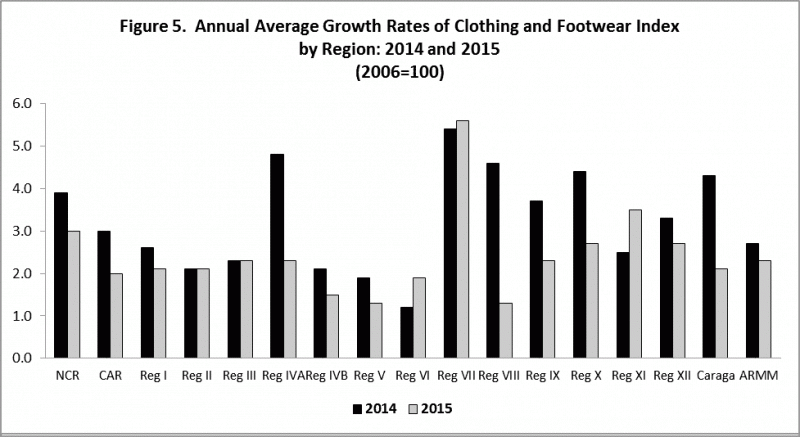
The annual average gains in indices for clothing and footwear in NCR and AONCR slowed down to 3.0 percent and 2.4 percent, respectively. Price upticks observed in selected clothing and footwear items in many regions were lower compared to their last year’s growths. The lowest annual average rate for the year was both recorded in Bicol Region and Eastern Visayas at 1.3 percent while Central Visayas had the highest rate of 5.6 percent. For the Philippines, the annual average uptick in clothing and footwear index eased to 2.6 percent.
LPG and kerosene were generally priced lower in NCR and in many provinces during the year. This factor pushed down the annual average change in housing, water, electricity, gas and other fuels index in NCR at -1.5 percent and in AONCR, -1.1 percent. Lower charges in the electricity rates in NCR and in selected regions also contributed to the downtrend. CALABARZON registered the lowest annual average rate at -3.9 percent while Zamboanga Peninsula recorded the highest growth of 5.0 percent. For the Philippines, the annual average rate of the group’s index went down by 1.3 percent.
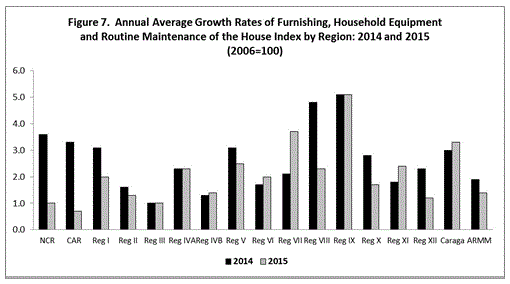
In 2015, the annual average increases in the indices of furnishing, household equipment and routine maintenance of the house in NCR and AONCR slowed down to 1.0 percent and 2.2 percent, respectively. The lowest annual average rate at 0.7 percent was observed in Cordillera Administrative Region (CAR) while the highest growth of 5.1 percent was noted in Zamboanga Peninsula. At the national level, annual average growth of the group’s index moved up at a slower pace of 1.9 percent.

In 2015, the health index in NCR and AONCR recorded slower annual average rates of 3.1 percent and 1.8 percent, respectively. On the average, slower annual rates were recorded in medicines and in charges for selected medical services. Among the regions, the lowest annual average growth of 0.5 percent was seen in CAR while the highest was in Northern Mindanao at 3.3 percent. At the national level, the annual average increase of the group’s index slid to 2.1 percent.
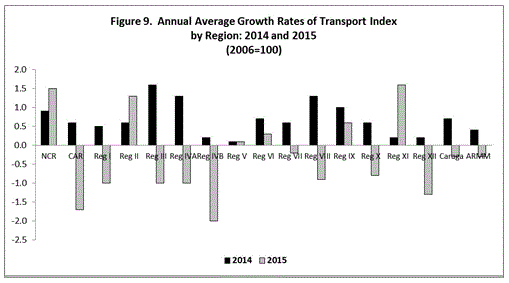
The general downward adjustments in the prices of gasoline and diesel during the year pushed down the annual average rate of the transport index in AONCR by 0.5 percent. Negative annual average movements were posted in eleven regions with MIMAROPA registering the lowest annual average adjustment during the year at -2.0 percent. On the other hand, air, train and ship transport fare hikes in NCR raised the annual average growth of the group’s index in the area by 1.5 percent. At the national level, the annual average change of the transport index fell by 0.1 percent.
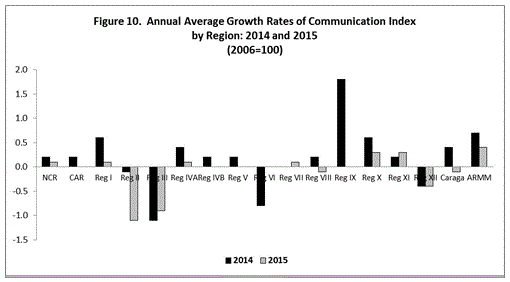
Charges for prepaid communication services and telephone rates went up in NCR. Moreover, increased charges for postal services related to letters and repair of mobile/cellular phones were also noted in the area. Thus, the annual average growth of communication index in NCR rose 0.1 percent in 2015. On the contrary, the annual average change in communication index in AONCR was -0.2 percent due to downward adjustments in the charges paid for internet access and declines in the prices of mobile cellular phones in selected provinces. The lowest annual average rate of -1.1 percent was noted in Cagayan Valley while the highest was in ARMM at 0.4 percent. The national index posted a zero percent annual average rate in 2015.
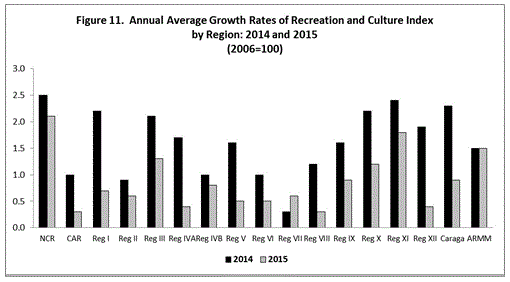
Compared to 2014, price increments in selected equipment, recreational items and school supplies were generally slower in NCR in 2015. Thus, the annual average growth in recreation and culture index in the area decelerated to 2.1 percent. Likewise, in AONCR, the annual average hike in the group’s index slowed down to 0.8 percent due to lower mark ups in movie admission fees and in selected recreational items. The lowest annual average growth of 0.3 percent was in CAR and Eastern Visayas while the highest was in Davao Region at 1.8 percent. For the Philippines, the group’s annual average growth was pegged at 1.1 percent.

The annual average growth of the education index in 2015 was registered at 5.6 percent in NCR due to higher tuition fee hikes in many provinces. Thus, the group’s index in AONCR stood at 3.8 percent. This was, however, slower than its last year’s rate of 4.9 percent. The lowest annual average growth was in Cagayan Valley at 1.3 percent while the highest was recorded in CAR at 6.7 percent. At the national level, the group’s index advanced by 4.2 percent.
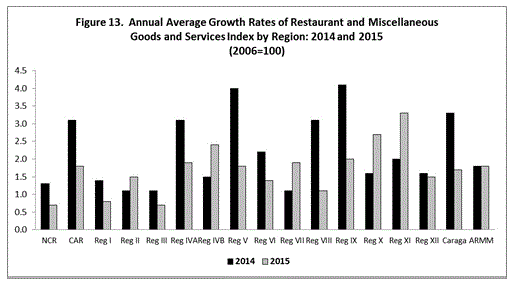
The index for restaurant and miscellaneous goods and services in NCR posted slower annual average growth of 0.7 percent in 2015. This was brought about by lower annual average gains in the prices of meals eaten outside the home in the area. Likewise, the annual average increase of the group’s index in AONCR decelerated to 1.6 percent due to slower annual average increments in the prices of selected items for personal care and effects in many provinces. At the country level, the annual average growth of the group’s index improved to 1.3 percent..
______________________________________________________________________________________
CPIs and inflation rates by province and selected city are also available upon request at Philippine Statistics Authority, Economic Sector Statistics Service, Price Statistics Division (Telephone Number: 376-19-59).
